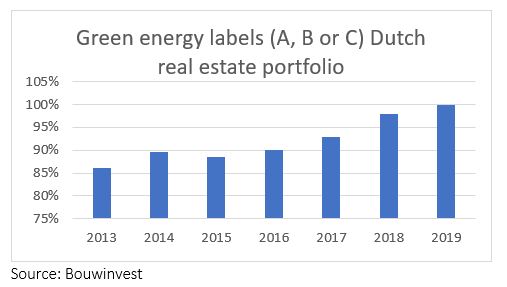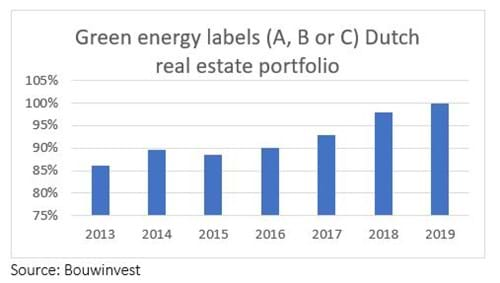- Home EN
- News
- Latest news
- 2020
- Bouwinvest well on track to meet energy-reduction targets
Bouwinvest well on track to meet energy-reduction targets
Bouwinvest is ahead of schedule to reach our goal of lowering the energy consumption of all our Dutch assets. In 2019, we reduced the amount of energy our residential, retail and office portfolios used by 7.7% as compared to 2018, more than double our annual target of 3%. We have now raised the bar, targeting a 5% per annum decrease from 2021 for all our Dutch portfolios so as to minimise the environmental impact of our activities, one of the key tenets of our socially responsible investment policy.
At Bouwinvest, investing in energy reduction is not just a question of taking our responsibility seriously in the transition from fossil-based fuels to renewables. We see it as a prerequisite for safeguarding the long-term financial returns of our assets. Energy-efficient buildings are both attractive to occupiers due to lower (service) costs and greater living comfort as well as better prepared for any future tightening of legislation and regulations. Such buildings are highly sought after by investors which means they maintain their value and generate robust returns for our clients, primarily Dutch pension funds. Social and financial returns therefore go hand in hand.
WTC Rotterdam leads the way
The energy reduction Bouwinvest achieved in 2019 was partly the result of various energy-saving measures introduced for assets in the Dutch portfolios, in particular the WTC building in Rotterdam. Bernardo Korenberg, Head of Sustainability & Innovation at Bouwinvest, said, "In all our buildings, we are investing in insulation and the installation of 'smart' heating, cooling and lighting systems. We are also spending heavily on renewable sources to save energy and curb CO2 emissions. But the substantial decline in energy consumption we achieved in 2019 is largely due to the improved level of sustainability of WTC Rotterdam."
WTC Rotterdam is a frequently cited example in the portfolio, partly because of the complexity of the project. As a result of our sustainability investment, the energy rating of the high-rise section of the building has risen from E to A, the highest level possible. The low-rise section of building is a national monument and not formally required to be upgraded to energy label A, but it too is being made more sustainable. Among other things, 100 new solar panels are being installed on the roof and LED lighting will replace the current system. These measures are expected to raise the energy label from G to A as well.
As a result of energy-saving measures in existing assets, combined with the purchase of sustainable buildings, the number of 'green' energy labels (A, B and C) has risen in recent years to 98% of the portfolio. The next step now is to increase the percentage of buildings with energy label A from 51% in 2019 to 55% in 2020.


Thanks to our investments and measures to reduce energy consumption in our buildings further, we have moved another step closer to our goal of a near-energy neutral or 'Paris Proof' real estate portfolio by 2045.
